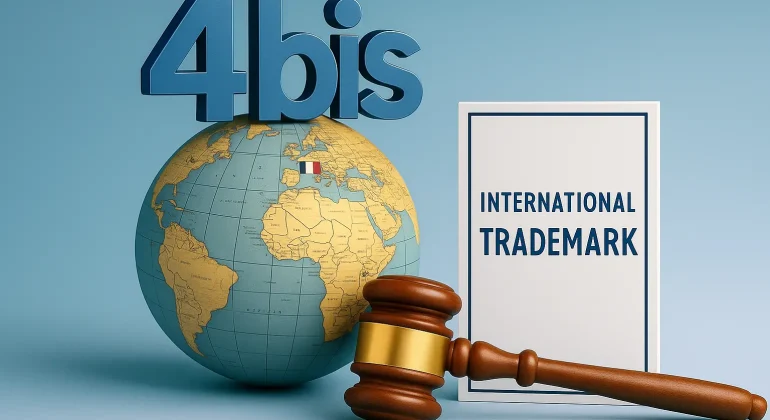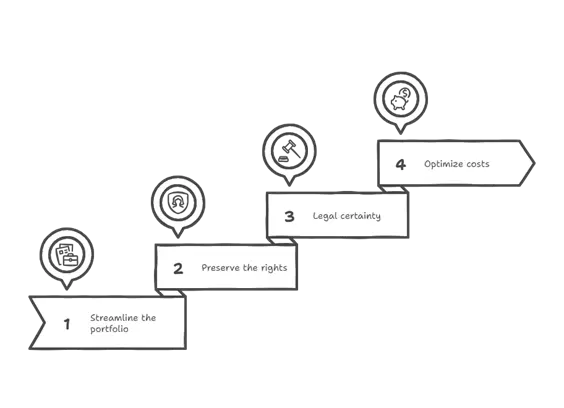Sommaire
Introduction
An international trademark is a mark registered with the World Intellectual Property Organization (WIPO) under the Madrid Protocol. This system allows a trademark owner to seek protection in multiple countries through a single procedure, thereby simplifying administrative formalities and optimizing the costs of international protection. An international trademark is recognized by all member states of the Madrid Protocol, provided that the basic mark has already been registered in a member country.
In this article, we present Article 4bis of the Madrid Protocol as a strategic lever enabling the substitution of national or regional trademark registrations with an international registration, thus consolidating rights, rationalizing the portfolio, and providing optimal legal security.
What is article 4bis?
Article 4bis of the Madrid Protocol provides that when a trademark already registered at the national or regional level (e.g., the EU) also becomes the subject of an international registration in the name of the same owner, and the designation takes effect after the date of the earlier mark, the international registration is deemed to replace the earlier registration, without prejudice to rights acquired under the latter. This provision does not cancel the initial registration but recognizes its legal equivalence with the international registration for protection in the relevant jurisdiction.
What does it provide for?
Automatic replacement applies as soon as the conditions are met (identical holder, identical mark, same scope of goods/services, later date). No formalities are strictly required, but they are highly recommended.Upon request, the national office must record a mention of the replacement in its register and notify WIPO’s International Bureau, which will enter the information into the International Register. This mention provides greater visibility for third parties and facilitates the administrative management of the portfolio.
Strategic issues in the use of article 4bis
Benefits and advantages
- Streamline the trademark portfolio by progressively eliminating redundant registrations.
- Preserve rights such as earlier priority or prior use of the mark.
The priority attached to the national trademark is automatically preserved when replacement occurs. Thus, if the national mark benefited from a priority claim under Article 4 of the Paris Convention, that priority is transferred by operation of law to the international registration that replaces it. The holder therefore retains the advantage of the earlier priority date, even if the national registration is not subsequently renewed. No particular formalities are required, as this protection flows directly from Article 4bis of the Madrid Protocol.
Similarly, the use made of the national trademark is deemed valid use of the international registration. In other words, continued exploitation of the national mark serves to demonstrate use of the international registration and prevents any action for cancellation based on non-use. This assimilation of use operates automatically, without the need for specific administrative steps. In practice, however, it remains essential to keep records of exploitation under the national mark, as such evidence may be relied upon in support of the international registration in the event of a dispute.
- Enhance legal security for third parties through an official mention in the registers.
It refers to an official entry in the registers that notifies that the national trademark has been replaced by an international registration in certain countries. This means that third parties (such as competitors or potential trademark holders) are informed of a change in the trademark’s status, ensuring that they are aware that the national registration has been replaced by an international registration and that international protection now applies.
- Optimize costs by consolidating renewals into a single international procedure.
What to expect / points of caution
- Both registrations (national and international) coexist as long as one or the other is renewed.
- The five-year dependency period of the international registration may pose a risk if the national mark is challenged during this time.
- The loss or cancellation of the basic national mark within this period results in the cancellation of the international registration in all designated jurisdictions.
Limitations
- Not all states recognize the automatic replacement of the national trademark by the international registration, or the option of partial replacement. It is therefore important to contact the trademark offices.
- Partial replacement is possible in certain jurisdictions (e.g., the United States since 2021 under the amended Rule 21) but requires detailed local analysis.
Since November 21, 2024, the United Kingdom has implemented a rule allowing the partial replacement of national registrations with international registrations. This rule enables trademark holders to request the partial replacement of their national registration with an international registration covering only a portion of the goods or services. There must be an overlap between the goods or services covered by the national registration and those of the international registration.
- This is not a transfer of rights but an administrative mention in the register accessible to third parties.
Article 4bis of the Madrid Protocol does not result in the transfer of ownership rights from the national or regional trademark to the international registration. In other words, the trademark holder retains all acquired rights on the national trademark, even after the international registration has come into effect.
The administrative mention in the register simply means that an entry is made in the official registers to indicate that the international registration legally replaces the national or regional registration in the relevant jurisdictions. This ensures better visibility for third parties.
Strategy to adopt
- Carry out a portfolio audit to identify national/regional marks that could be replaced.
- Verify that the international registration covers the full scope of goods/services, including in their exact or equivalent wording.
- File a request with the national office to record the substitution and secure the information.
- Monitor the five-year dependency period and keep the national registration active if necessary.
- Take advantage of partial replacement mechanisms in countries where admitted, to align protection with real business needs.
In certain countries, such as the United Kingdom, this replacement may be partial: only some goods or services are transferred to the international registration, while the others remain covered by the national mark. This helps avoid duplication and allows the protection to be adjusted to actual needs.
Conclusion
Ultimately, Article 4bis is a precise tool for consolidating trademark rights at the international level while preserving initial rights. When properly used, it allows for a streamlined management of a portfolio, stronger legal certainty, and cost optimization.
Dreyfus Law firm is well-versed in the subject and the technicalities of international trademarks. The firm assists its clients in managing complex intellectual property cases, offering personalized advice and comprehensive operational support for the complete protection of intellectual property.
Dreyfus Law firm is partnered with a global network of lawyers specializing in intellectual property.
Nathalie Dreyfus with the assistance of the entire Dreyfus team.
FAQ
What are the conditions for replacement to apply?
Replacement applies when the trademark owner is identical, the trademark itself is identical, the goods/services are equivalent, and the international designation takes effect after the national or regional registration.
Does the national registration disappear after replacement?
No, the national registration continues to exist, but it is legally replaced by the international registration for the designated jurisdictions.
Is it mandatory to record the replacement mention with the national office?
No, recording the mention is not mandatory, but it is highly recommended to secure the substitution and guarantee legal visibility. We recommend contacting an intellectual property expert to ensure that your protection strategy is adequate and properly secured.
Can the basic mark be replaced?
Yes, the basic mark can be replaced by an international registration, provided that the conditions for replacement are met. In fact, this will be possible after the five-year dependency period provided for under the Madrid system.
Does the five-year dependency period have an impact on strategy?
Yes, the five-year dependency period means that the international registration depends on the maintenance of the basic mark, which may introduce risks if the national mark is challenged.


